Chip designer Allegro MicroSystems (NASDAQ:ALGM) announced better-than-expected results in Q1 CY2024, with revenue down 10.7% year on year to $240.6 million. On the other hand, next quarter's revenue guidance of $165 million was less impressive, coming in 22.7% below analysts' estimates. It made a non-GAAP profit of $0.25 per share, down from its profit of $0.37 per share in the same quarter last year.
Allegro MicroSystems (ALGM) Q1 CY2024 Highlights:
- Revenue: $240.6 million vs analyst estimates of $235 million (2.4% beat)
- EPS (non-GAAP): $0.25 vs analyst estimates of $0.21 (17.1% beat)
- Revenue Guidance for Q2 CY2024 is $165 million at the midpoint, below analyst estimates of $213.4 million
- Gross Margin (GAAP): 51.2%, down from 56.8% in the same quarter last year
- Inventory Days Outstanding: 126, up from 124 in the previous quarter
- Free Cash Flow was -$1.51 million, down from $42.16 million in the previous quarter
- Market Capitalization: $5.67 billion
The result of a spinoff from Sanken in Japan, Allegro MicroSystems (NASDAQ:ALGM) is a designer of power management chips and distance sensors used in electric vehicles and data centers.
Sales Growth
Allegro MicroSystems's revenue growth over the last three years has been strong, averaging 22.9% annually. But as you can see below, its revenue declined from $269.4 million in the same quarter last year to $240.6 million. Semiconductors are a cyclical industry, and long-term investors should be prepared for periods of high growth followed by periods of revenue contractions (which can sometimes offer opportune times to buy).
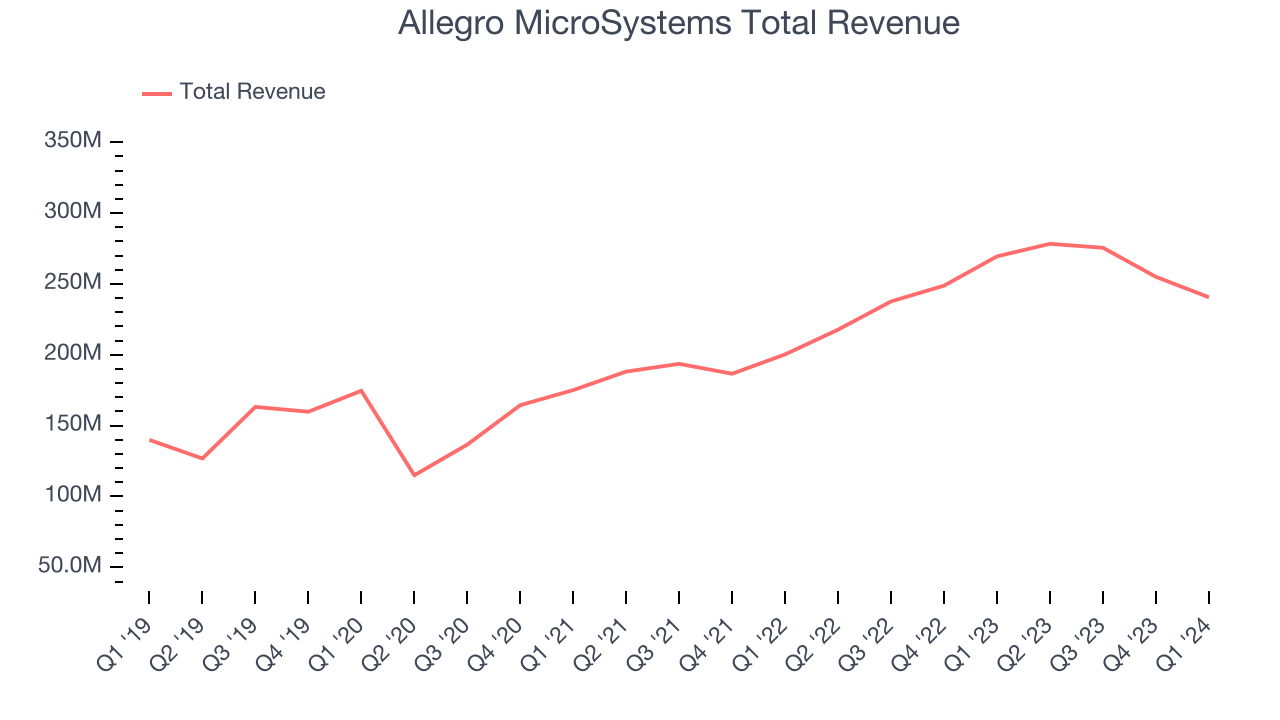
Even though Allegro MicroSystems surpassed analysts' revenue estimates, this was a slow quarter for the company as its revenue dropped 10.7% year on year.
Allegro MicroSystems's revenue inverted from positive to negative growth this quarter, which was unfortunate to see. Looking ahead to the next quarter, the company's management team forecasts a 40.7% year-on-year revenue decline. Analysts seem to agree that the poor performance will continue, as their estimates for the next 12 months call for a 10% drop in revenue.
Product Demand & Outstanding Inventory
Days Inventory Outstanding (DIO) is an important metric for chipmakers, as it reflects a business' capital intensity and the cyclical nature of semiconductor supply and demand. In a tight supply environment, inventories tend to be stable, allowing chipmakers to exert pricing power. Steadily increasing DIO can be a warning sign that demand is weak, and if inventories continue to rise, the company may have to downsize production.
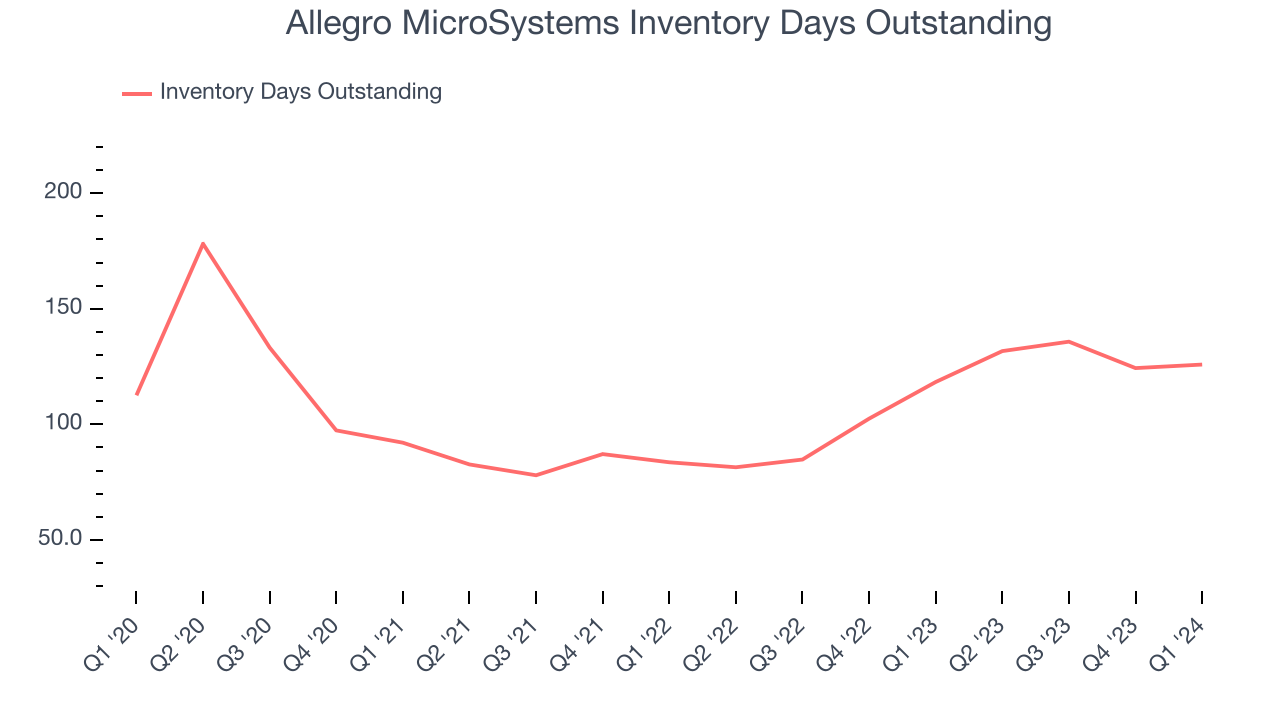
This quarter, Allegro MicroSystems's DIO came in at 126, which is 17 days above its five-year average, suggesting that the company's inventory has grown to higher levels than we've seen in the past.
Pricing Power
In the semiconductor industry, a company's gross profit margin is a critical metric to track because it sheds light on its pricing power, complexity of products, and ability to procure raw materials, equipment, and labor. Allegro MicroSystems's gross profit margin, which shows how much money the company gets to keep after paying key materials, input, and manufacturing costs, came in at 51.2% in Q1, down 5.6 percentage points year on year.
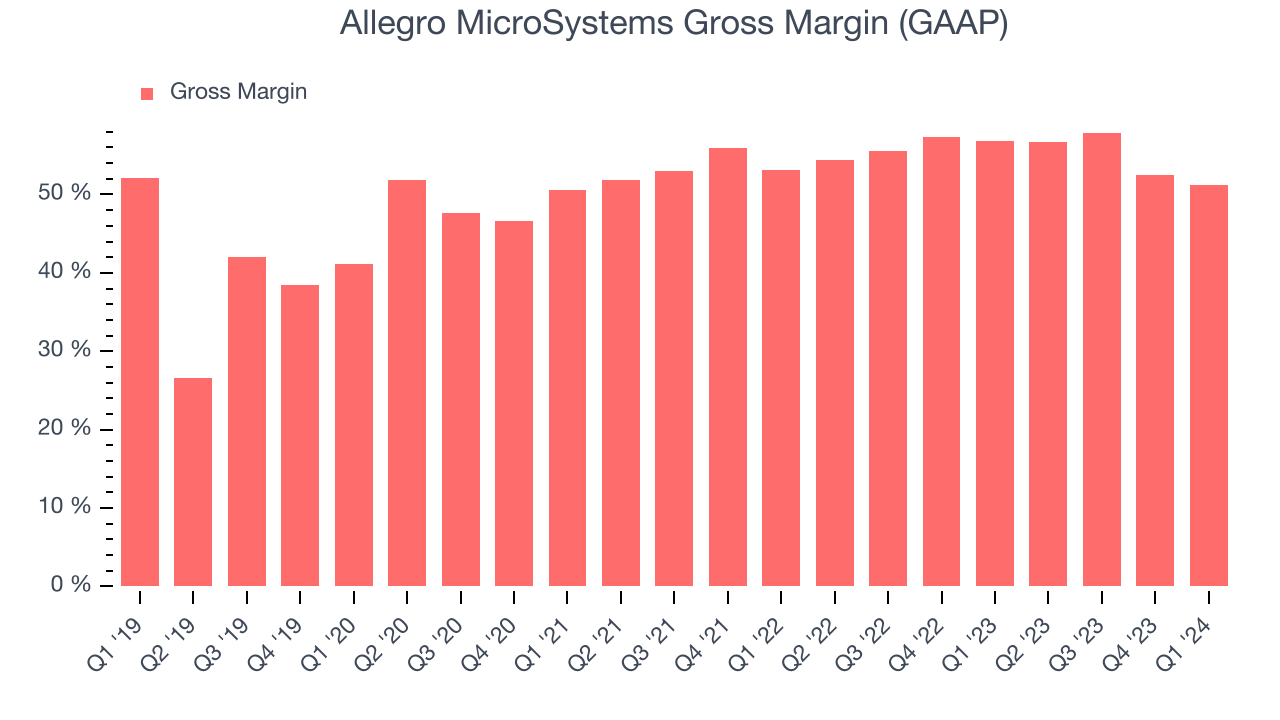
Despite declining over the past year, Allegro MicroSystems still retains industry standard gross margins, averaging 54.8%, pointing to its competitive offering, decent cost controls, and possibly modest pricing pressure.
Profitability
Allegro MicroSystems reported an operating margin of 23.8% in Q1, down 6.4 percentage points year on year. Operating margins are one of the best measures of profitability because they tell us how much money a company takes home after manufacturing its products, marketing and selling them, and, importantly, keeping them relevant through research and development.
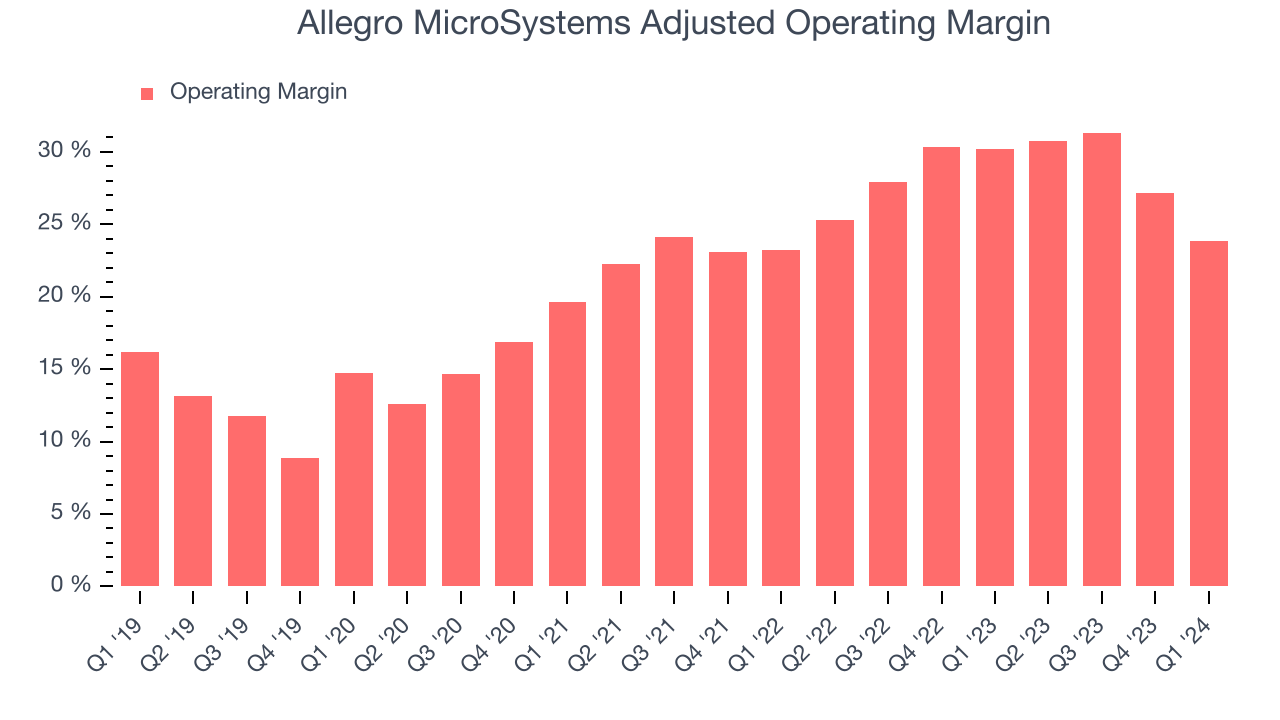
Allegro MicroSystems's operating margins have been stable over the last year, averaging 28.5%. Additionally, the company's margins are in line with its peer group, indicating that it's appropriately spending on procurement, manufacturing, R&D, marketing, and general business expenses.
Earnings, Cash & Competitive Moat
Wall Street expects earnings per share to decline 30.4% over the next 12 months, although estimates will likely change after earnings.
Although earnings are important, we believe cash is king because you can't use accounting profits to pay the bills. Allegro MicroSystems's free cash flow came in at negative $1.51 million in Q1, down 109% year on year.
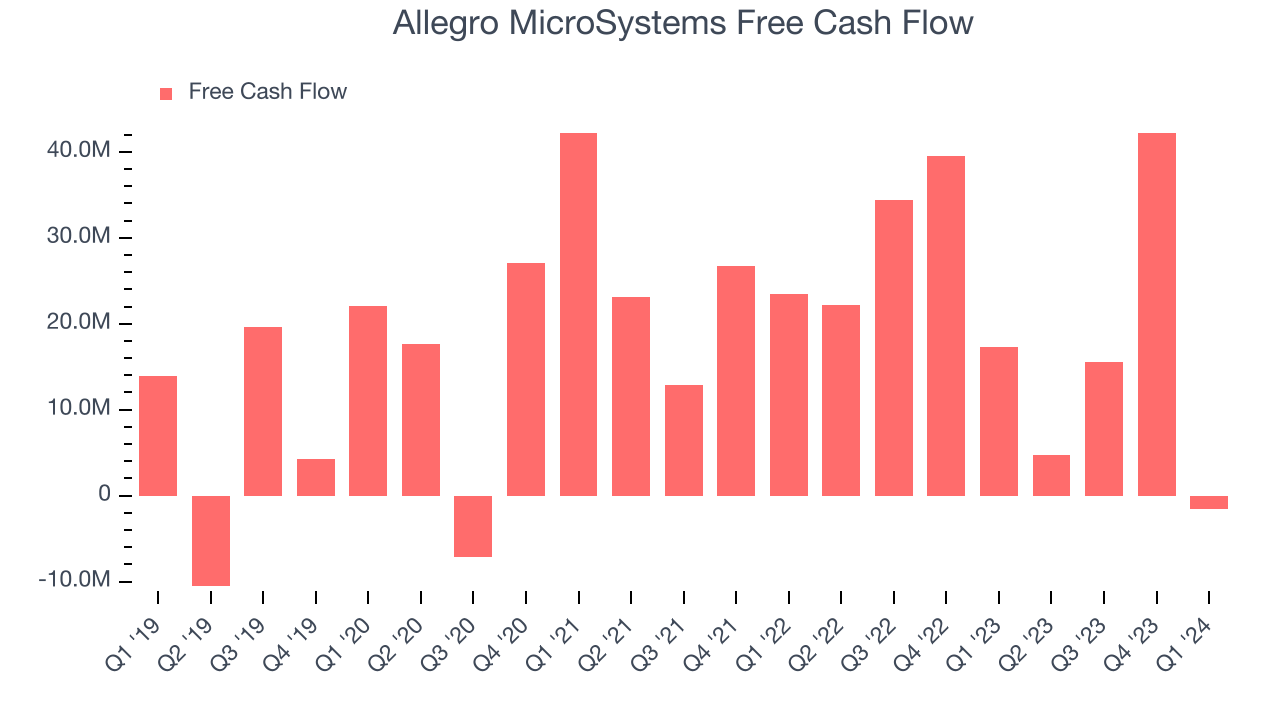
Allegro MicroSystems has generated $60.94 million in free cash flow over the last 12 months, or 5.8% of revenue. This FCF margin enables it to reinvest in its business without depending on the capital markets.
Return on Invested Capital (ROIC)
EPS and free cash flow tell us whether a company was profitable while growing revenue. But was it capital-efficient? A company’s ROIC explains this by showing how much operating profit a company makes compared to how much money the business raised (debt and equity).
Allegro MicroSystems's five-year average ROIC was 17.6%, somewhat low compared to the best semiconductor companies that consistently pump out 35%+. Its returns suggest it historically did a subpar job investing in profitable business initiatives.
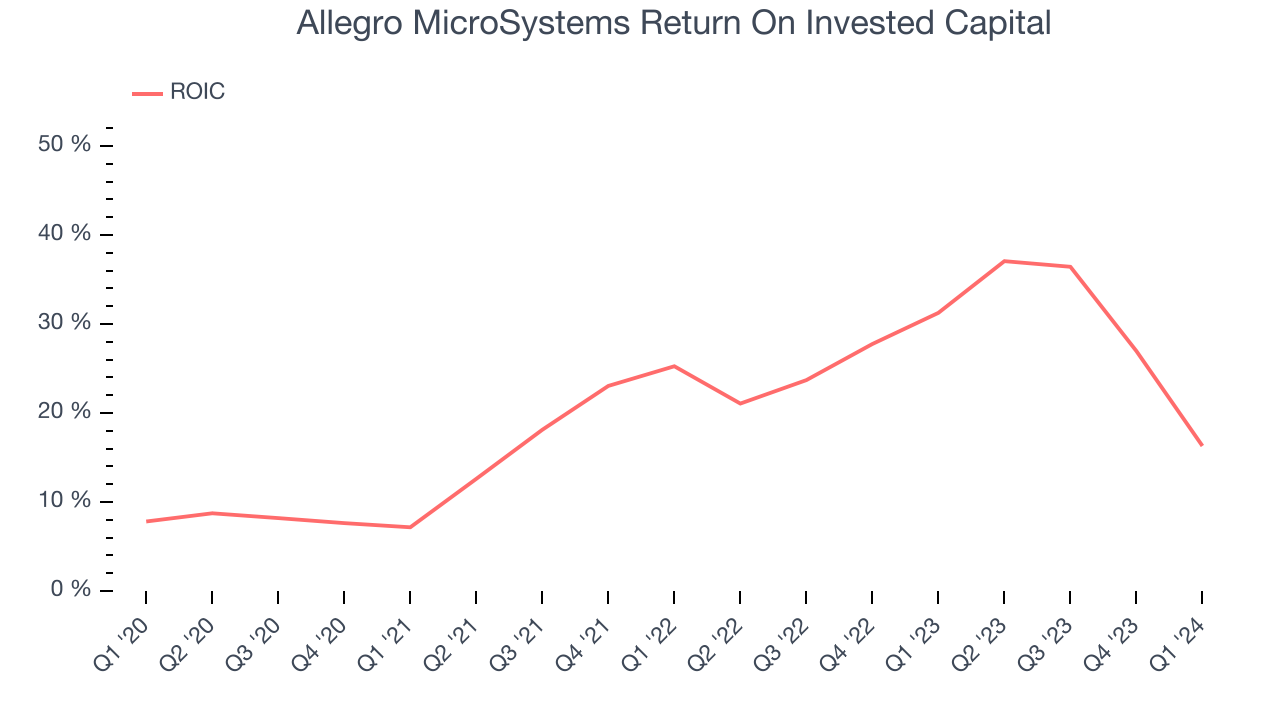
The trend in its ROIC, however, is often what surprises the market and drives the stock price. Over the last few years, Allegro MicroSystems's ROIC has significantly increased. This is a good sign, and we hope the company can continue improving.
Key Takeaways from Allegro MicroSystems's Q1 Results
We were impressed by how significantly Allegro MicroSystems blew past analysts' EPS expectations this quarter. We were also glad its revenue outperformed Wall Street's estimates. On the other hand, its revenue guidance for next quarter missed analysts' expectations and its operating margin shrunk. Overall, the results could have been better. The company is down 1.4% on the results and currently trades at $28.97 per share.
Is Now The Time?
When considering an investment in Allegro MicroSystems, investors should take into account its valuation and business qualities as well as what's happened in the latest quarter.
We cheer for everyone who's making the lives of others easier through technology, but in the case of Allegro MicroSystems, we'll be cheering from the sidelines. Although its revenue growth has been strong over the last three years, Wall Street expects growth to deteriorate from here. And while its gross margins are about normal for a semiconductor business, the downside is its low free cash flow margins give it little breathing room. On top of that, its mediocre ROIC suggests it has grown profits at a slow pace historically.
Allegro MicroSystems's price-to-earnings ratio based on the next 12 months is 33.3x. While we've no doubt one can find things to like about Allegro MicroSystems, we think there are better opportunities elsewhere in the market. We don't see many reasons to get involved at the moment.
Wall Street analysts covering the company had a one-year price target of $38.36 per share right before these results (compared to the current share price of $28.97).
To get the best start with StockStory check out our most recent Stock picks, and then sign up to our earnings alerts by adding companies to your watchlist here. We typically have the quarterly earnings results analyzed within seconds of the data being released, and especially for the companies reporting pre-market, this often gives investors the chance to react to the results before the market has fully absorbed the information.
